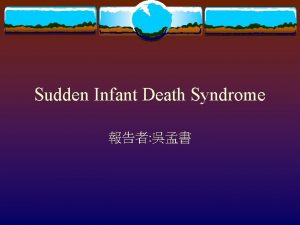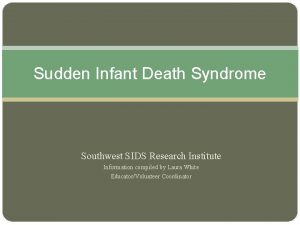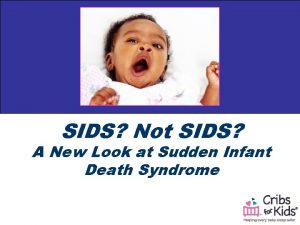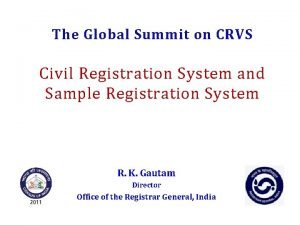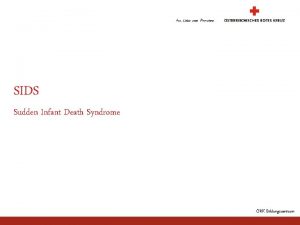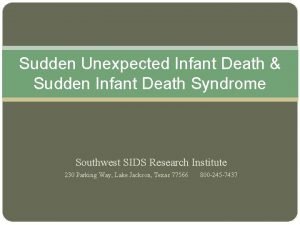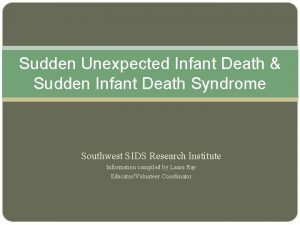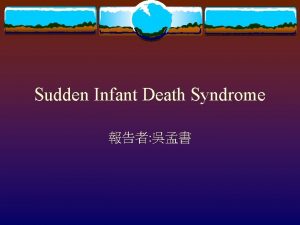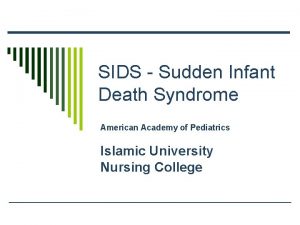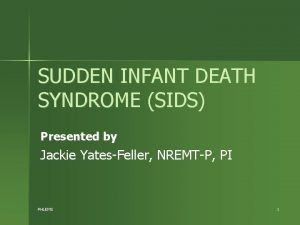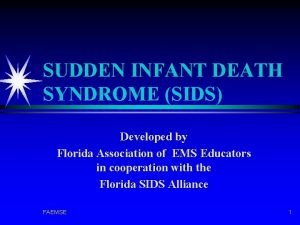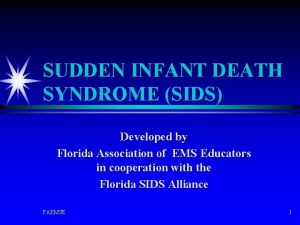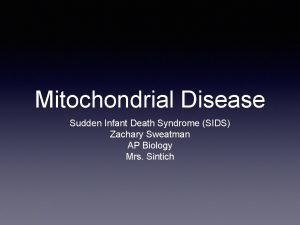Caring for an Infant SIDS Sudden Infant Death














- Slides: 14

Caring for an Infant

SIDS • Sudden Infant Death Syndrome • The sudden, unexplained death of an apparently healthy child. • They are often under one year old.

Prevention Strategies for SIDS • Have the child sleep on their back. • Do not sleep with soft bedding, pillows, or stuffed animals • Avoid smoking and second-hand smoke both during and after pregnancy.

Four Basic Cries • Hunger - The most demanding cry • Pain - Most obvious, fearful cry of all • Bored - Grows louder and more intense if ignored • Anger - Loud, demanding and varied • Meeting crying needs appropriately develops trust and teaches a child about positive attention getting.

Crying Plan • Have a crying plan so that when the baby cries you know what to do or check and how to handle it.

Crying Plan • Check for the basic needs: – Hungry – Needing a diaper change – Is too hot or cold – Has a fever or illness – Sensitivities to milk consumed (breast or bottle)

Crying Plan • Try various calming techniques: – Rocking – Singing – Warm Bath – Car Ride – White Noise

Coping Threshold • How much a person can take of something. • If you reach your coping threshold for crying, try the following: – Put the baby in its crib – Close the door – Go do something to relieve your stress • Play loud music, vacuum, watch TV, sit on the front porch

Anyone Can Lose It • Everyone is a potential abuser based on the abuse formula: Child + Caregiver + Stress = Abuse

Shaken Baby Syndrome • Caused by jostling an infant’s head and neck back and forth with enough force that the brain tissue moves inside the skull and becomes damaged. • Usually in an effort to make the child stop crying.

Consequences to the Infant • If the child is shaken and lives: – Child’s quality of life may be compromised – Suffer long term disabilities – Brain damage – Paralysis – Blindness • Shaking a child under 2 years old can cause permanent brain damage and possibly death.

What Can We Do? • We are all at risk for shaking a baby. • A tired, stressed out caregiver can lose control and shake a baby to get it to stop crying. • Our job is not to stop the crying, but to find out why the baby is crying and do our best to meet the baby’s needs.

Elijah’s Story • This is a shaken baby syndrome documentary. • The short life of Elijah, a 16 -month-old baby boy who was shaken to death by his biological father.

Summary • SIDS is an unexpected death of an infant. Look for ways to prevent this from happening. • Babies will cry. Be prepared for that. Figure out your crying plan and never shake a baby!!
 Livedo mortis
Livedo mortis Dr. jean watson
Dr. jean watson Sids mid atlantic
Sids mid atlantic Stexas
Stexas Triple risk model sids
Triple risk model sids Triple risk model sids
Triple risk model sids Sudden death proc
Sudden death proc Sudden oak death map
Sudden oak death map Sudden oak death map
Sudden oak death map Infant death rate
Infant death rate Forensic pathology examples
Forensic pathology examples How many syllables in robin
How many syllables in robin Hazen williams formula
Hazen williams formula Sudden fiction meaning
Sudden fiction meaning Gradual contraction loss coefficient
Gradual contraction loss coefficient
